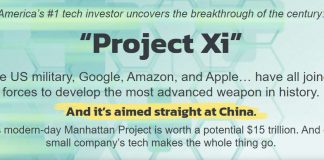Financial investment newsletters provide stock tips and analysis.
A good financial investment newsletter helps you understand the market. It alerts you to upcoming trends before they’re mainstream. It helps you understand when to buy to maximize gains, and when to sell to minimize losses.
Some financial investment newsletters cater to the ‘get rich quick’ crowd, claiming you can make lots of money quickly by following their recommendations.
Other newsletters cater to patient investors or those with long timeframes. Some market themselves mostly to retirees or older investors on a fixed income.
Whatever you’re looking for, there’s a financial newsletter for you.
Contents
- 1 Ranking the Top Financial Investment Newsletters in 2020
- 2 How We Ranked the Best Financial Email Newsletters
- 3 Who Should Subscribe to Financial Investment Newsletters?
- 4 Benefits of Financial Investment Newsletters
- 5 FAQs About Financial Investment Newsletters
- 5.1 Q: What’s the best financial investment newsletter?
- 5.2 Q: What will I learn from a financial newsletter?
- 5.3 Q: How much does a financial newsletter cost?
- 5.4 Q: Do financial newsletters come via email or print?
- 5.5 Q: Why are some financial newsletters so expensive?
- 5.6 Q: Are financial newsletters a scam?
- 5.7 Q: Is it safe to buy the recommended stocks in a financial newsletter?
- 5.8 Q: Can financial newsletters regularly beat the market?
- 5.9 Q: Can I get rich quick with financial newsletters?
- 5.10 Q: How do I subscribe to a financial newsletter?
- 5.11 Q: Why should I pay for a financial newsletter?
- 5.12 Q: I don’t have a large portfolio. Should I still sign up for a financial newsletter?
- 6 Final Word
Ranking the Top Financial Investment Newsletters in 2020
We’re experts in the financial newsletter space. Here’s how our editorial team ranked the best financial investment newsletters of 2020:
Palm Beach Research Group

Palm Beach Research Group is an investment advisory firm that offers a wide range of eBooks, subscriptions, and other services to both free and paying subscribers.
The company’s flagship financial newsletter is called The Palm Beach Letter. Editor Teeka Tiwari recommends safe, income-producing assets like dividend paying stocks. Tiwari is a former hedge fund manager. He has also recently been a big advocate for crypto investing, and he edits newsletters like Palm Beach Crypto Income Quarterly, which highlights the best crypto trades to make.
Other company newsletters are riskier. Palm Beach Research Group has a significant presence in the cryptocurrency space, for example, and frequently recommends cryptocurrencies with five digit percentage gains. Teeka Tiwari, who hosted the 5 coins to $5 Million series, as well as his blockchain stocks presentation titled “Investment of the Decade“, this is by far the number one most successful bitcoin, blockchain and cryptocurrency related financial investment newsletter service available online.
Palm Beach Research Group publishes significant information for free online, including its daily newsletter Palm Beach Daily. The company also publishes webinars, online seminars, and other training videos for free.
Palm Beach Research Group has some unusual, flashy marketing tactics – particularly when advertising its crypto-related services. However, if you comb through the marketing, you can find good information throughout Palm Beach Research Group’s products and services.
Price: $0 to $2,500 Per Year
Watch The Investment of the Decade with Teeka Tiwari Today
Stansberry Research
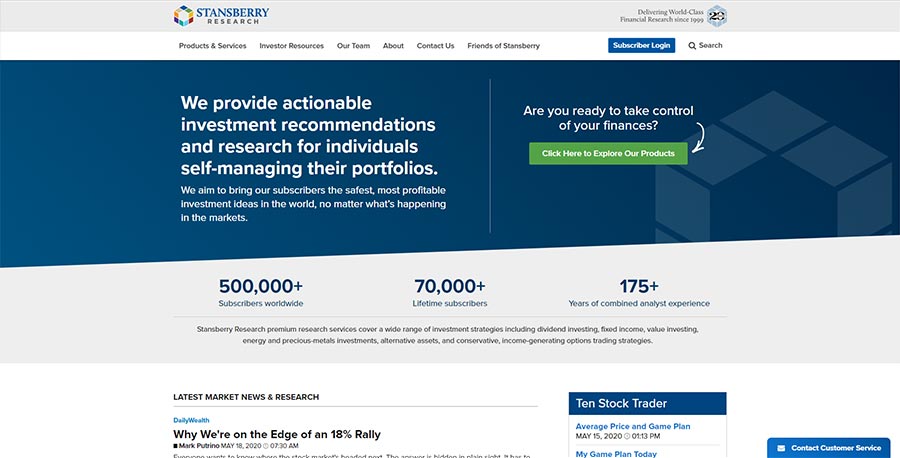
Stansberry Research offers several free and paid financial newsletters. Whether you want to pay $0 per year or $2,5000 per year for a financial newsletter subscription, Stansberry Research might have the right option for you.
Stansberry Research provides investment recommendations and research for anyone self-managing their portfolio. Many of the company’s newsletters advocate intelligent, research-backed, long-term investing for steady financial growth. However, the company also offers short-term trading newsletters, alternative financial advice, and more.
Stansberry Research is also one of the few financial reporting companies on this list to offer invitation-only subscription services, including the Permanent Wealth Program. Other popular newsletters, including Stansberry NewsWire, Stansberry Digest, Cryptocurrency Masterclass, Stansberry Investor Hour, Stansberry Innovations Report and others are free.
If you’re looking for actionable investment recommendations at any price, then Stansberry Research may be the right choice.
Price: $0 to $199 Per Year
Check Out the Stansberry Innovations Report Today
Agora Financial

Agora Financial promises to offer unbiased, knowledgeable financial advice that lets you protect and grow your wealth. Like Stansberry Research, Agora Financial provides a range of free and paid financial newsletters. You can choose the subscription that works for you – whether you’re looking for free investment advice or $1,000 per year investment advice.
Agora Financial has different strategies, but they emphasize common goals across all services. They aim for safe haven investments, for example, which is why many of their newsletters advocate precious metals and bonds.
They also aim to identify companies poised for rapid growth, telling investors to buy the right stock at the right time before it becomes big. That’s why you’ll see newsletters like 25 Cent Trader next to newsletters like Family Wealth Circle and Buyout Millionaires Club.
Agora Financial traces its roots back to the 1980s, when the team published financial guides like Strategic Investment (1984) and Plague of the Black Debt (1992). Their flagship newsletter, The Daily Reckoning, was launched in 1999 and still exists today. Agora Financial is based in Baltimore.
Price: $0 to $2,500 Per Year
Watch and Read the Battle for America Presentation
Motley Fool Stock Advisor
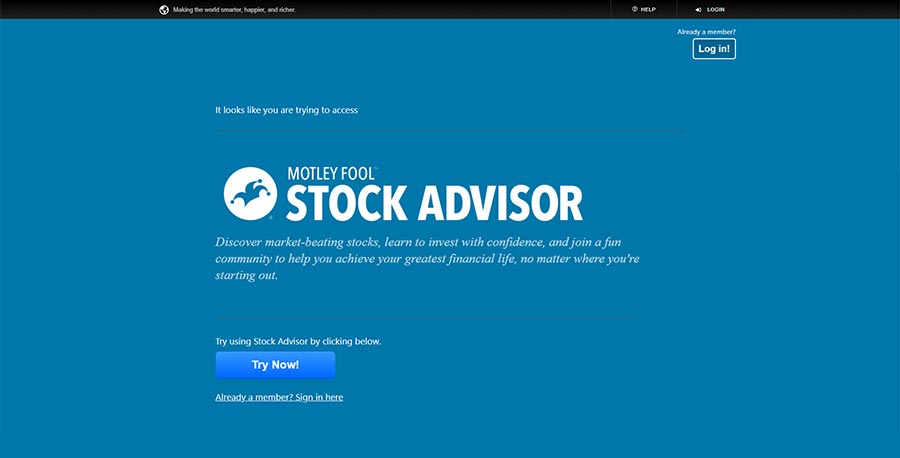
Motley Fool is one of the internet’s most influential investment websites. Founded in 1993, Motley Fool also offers a very good financial newsletter called Stock Advisor. Motley Fool’s newsletter was based on the same premise as the Motley Fool website: to help investors gain financial freedom.
Stock Advisor is priced at $99 per year or $1.90 a week. Members get access to a huge library of stock recommendations, including concrete advice that can help increase your net worth. As with most Motley Fool recommendations, this advice is catered to the average investor. You won’t find jargon or confusing terms. You’ll find research-backed information delivered in a no-nonsense way.
As a Stock Advisor subscriber, you receive curated stock picks every month in your email inbox. Stock Advisor has 600,000 active members and claims to outperform the market 3-to-1 by doing a deep dive into multiple industries, helping investors find overlooked gems poised for big gains.
Motley Fools’ stock tips have been very strong lately. The company recommended buying Zoom on October 3, 2019. The stock doubled in price by spring 2020.
We also appreciate the transparency of Motley Fool. The company publishes all previous stock tips online. Want to see what would have happened if you bought Motley Fool’s recommended stock in April 2016 and held it until 2020? You can do that.
Motley Fool is a media empire. The company offers podcasts, minute-by-minute news updates, newspaper columns, and premium investment newsletters. If you want intelligent information from a trusted brand, then Stock Advisor is a great option.
Price: $99 Per Year
Profitly by Tim Sykes
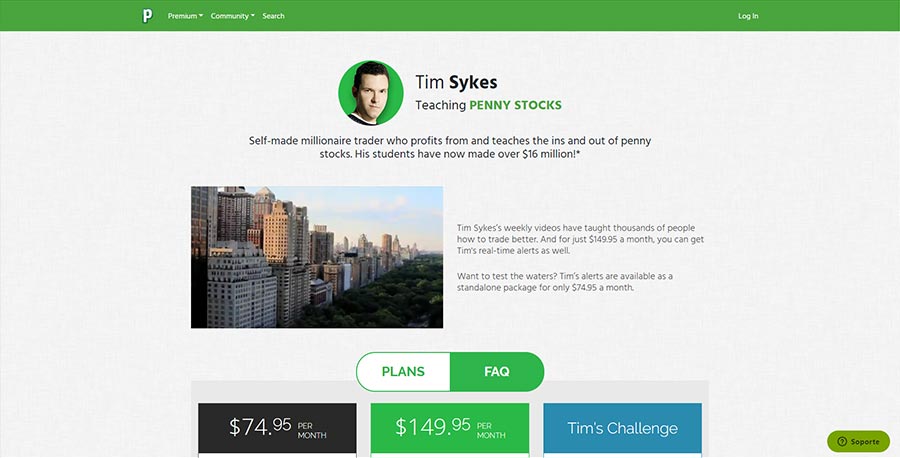
Tim Sykes is an investor who famously started day trading penny stocks, turning his $12,000 of bar mitzvah money into a multi-million dollar portfolio. Today, Sykes is in his late 30s and continues to share investment information online through Profitly, a paid subscription service.
Profitly is a popular subscription-based investment service with approximately 120,000 members. Profitly aims to combine accountability, transparency, and data-driven optimization with intelligent investment recommendations.
In addition to Sykes, Profitly shares information from other investment gurus. You can follow their stock tips and recommendations, for example. Or, you can just follow Sykes’ portfolio: subscribers can see every trade that Sykes makes.
Want to copy the moves top investors are making? Do you like someone’s investment advice and want to track their portfolio trade by trade? Profitly was created to allow investors to do exactly that.
Sykes also offers a handful of other paid subscriptions, including 9:30AM Profits Summit, Supernova, TimAlerts, Pennystocking Silver, Millionaire Challenge, Millionaire Masters Program, Small Cap Millionaire, and more. Expect lots of high-risk, low-cost plays – like the penny stocks that originally made Sykes rich.
Profitly explains information in a way that makes sense for ordinary investors, although it’s priced at a level that makes more sense for advanced investors. At $75 to $150 per month (there are two tiers), Profitly gives subscribers daily chatroom access, a daily 5 to 10 stock watchlist, real-time push alerts and trade alerts, an Android or iPhone app, video tutorial library access, and more.
Price: $75 to $150 Per Month
Click Here to Get Tim Sykes Morning Profits
Jim Cramer Action Alerts Plus

Jim Cramer Action Alerts Plus is a financial newsletter backed by one of the best-known names in the game. At the end of each week, Cramer does a weekly roundup of all shares he currently owns. You discover the portfolio of an expert and learn why he picked those stocks.
Cramer gives detailed information on the stock, the action being taken on that stock, and why that action is being taken. Subscribers also get real-time trade alerts, access to the $2.5 million charitable trust portfolio, and critical market insight.
Many traders also appreciate Jim Cramer’s investment indices, which let you track markets based on your investment goals. There’s a Growth, Value, Income, and Blend index, for example, letting you match your portfolio to your stock goals.
You can buy Jim Cramer’s Action Alerts Plus through his company, TheStreet, which he founded in 1996.
Price: $300 Per Year
Fidelity Investor

Published since 1998, Fidelity Investor is an award-winning investment newsletter that emphasizes safe, effective, and profitable investments.
Fidelity Investor is popular among retirement investors and active traders. Subscribers get access to premium research at a reasonable price. A one-year subscription costs $100.
Fidelity Investor has several model portfolios. The company publishes its monthly, annual, and five-year returns for each portfolio upfront. You can view the YTD returns, 5-year annualized returns, and last month’s return, for example, without subscribing to Fidelity Investor.
As of May 2020, Fidelity Investor’s Model Portfolios have a 5-year annualized return of 2.4% to 9.1%. Portfolios have names like Global Quant Growth, Income, S&P 500, Annuity Growth, allowing you to select the one that works best for your investment goals.
Price: $100 Per Year
Zacks
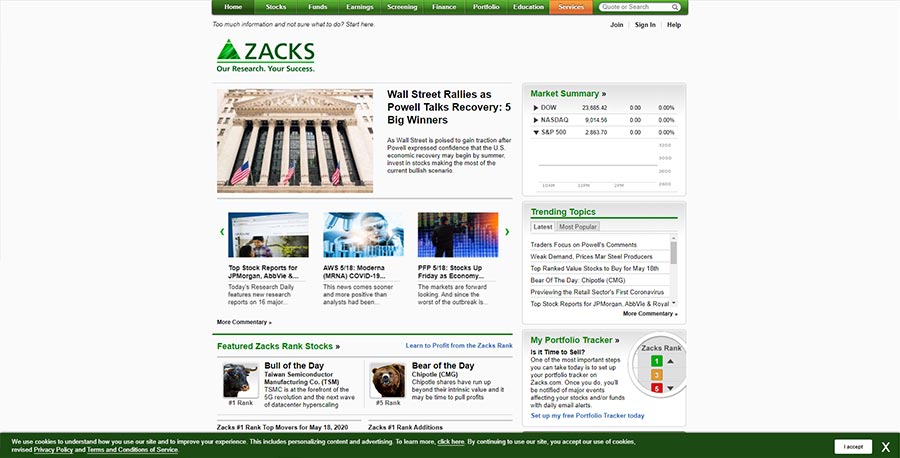
Zacks Investment Research has three newsletters that arrive in your inbox each weekday morning, giving you a summary of the market and what the market means for investors.
Zacks, like most other financial companies on this list, publishes significant information for free online, letting you get an idea of what to expect from Zacks’ paid products. You can register for free, then sign up for paid subscriptions like Zacks Ultimate, which lists specific trades.
Zacks offers three main financial newsletters, including Zacks Premium, Zacks Investor Collection, and Zacks Ultimate.
Plus, both the Zacks Investor Collection and Zacks Ultimate come with a free 30 day trial. Because of all of these advantages, Zacks seems to stand behind its products more than any other company on this list. At $250 per year for the cheapest subscription, however, Zacks certainly isn’t cheap.
Price: $249 to $3,000 Per Year
Nate’s Notes
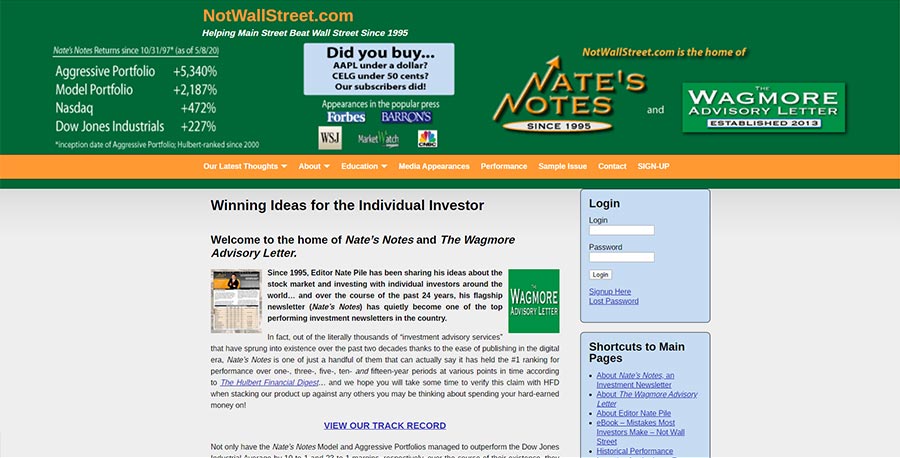
Nate’s Notes is a monthly investment newsletter designed to be easy for the average investor to read. Since 1995, editor Nate Pile has shared his ideas about the stock market. Nate’s Notes publishes its track record upfront, letting you see historic gains and losses for the company’s two flagship funds.
Nate’s Notes has experienced historically strong performance in its Model Portfolio and Aggressive Portfolio, outperforming the Dow Jones Industrial Average by 10 to 1 and 23 to 1 margins, respectively, over the course of their existence.
Nate’s Notes has had many famous recommendations over the years. He recommended buying Apple (AAPL) for less than $1 per share, for example. Other biotech and high-tech recommendations have also been extremely successful.
Nate’s Notes is a little rough around the edges. The site doesn’t look like it has been updated much since launching in 1995. Instead of investing in professional design, Nate’s Notes emphasizes good content.
We also appreciate the sensible approach to investing taken by Nate’s Notes. Instead of emphasizing “get rich quick” stock tips, day trading, or high-risk/high-reward plays, Nate’s Notes emphasizes intelligent value investing for long-term returns. You can easily follow the portfolio with just one trading day per month.
Price: $289 Per Year
The Speculative Investor
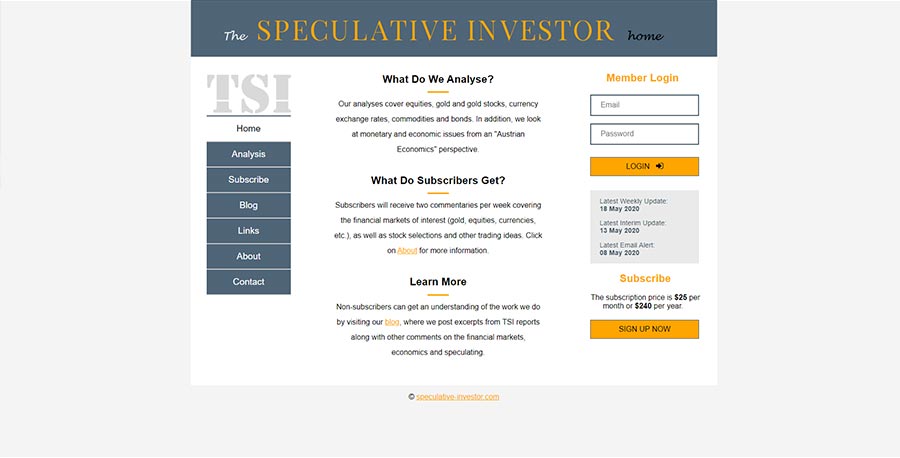
The Speculative Investor combines technical analysis with macroeconomic analysis, covering equities, gold, gold stocks, forex, commodities, bonds, and more. It’s more “alternative” financial advice than the more traditional newsletters on our list. However, that’s why the word “speculative” is directly in the name.
Subscribers receive two commentaries per week covering all of the financial markets mentioned above. The newsletter also features specific stock picks and other strategies to boost your portfolio.
For those interested in alternative views on non-traditional trading assets, The Speculative Investor may be the right choice – although it’s certainly not for everyone.
Price: $240 Per Year
Kiplinger’s Personal Finance

Kiplinger’s is a monthly financial magazine that aims to help you manage your money beyond just your investment portfolio. The newsletter features stock tips and investment recommendations, but it also covers topics like home ownership, buying a car, and saving for retirement.
Overall, subscribers can expect low-cost, long-term investing for safe, steady gains over time. It won’t promise to get you rich quick, but it will explain how to establish a good nest egg for retirement.
Kiplinger’s is one of the broadest financial newsletters in the industry, covering things like the latest financial trends, market analysis, individual stock picks, mutual funds and ETFs, bond investing, retirement planning, real estate, bank accounts, car buying, home ownership, and more.
Kiplinger’s is also the most affordable newsletter on our list (aside from the free newsletters), priced at just $20 per year. You can choose a digital or print subscription (or both).
Price: $20 Per Year
How We Ranked the Best Financial Email Newsletters
Financial newsletters make similar promises. Most claim to help you get richer. Few newsletters live up to that promise, however. We separated good and bad newsletters based on the following:
Expert Experience: Some financial newsletters are written by people who simply aggregate information they found online – they have limited firsthand investing experience. Other financial newsletters are written by former hedge fund managers or investment company executives. Whose advice would you rather follow?
Content Depth: Does the financial newsletter go into detail about its recommendations? Do they provide deep content? Or is it mostly just headlines and hot stock tips?
Research: Does the newsletter back up its claims with research? Does the newsletter take the time to cite its sources? Or is the newsletter just making things up?
Price & Value: Some financial newsletters are free, while others cost thousands per year. We featured newsletters for any budget, although we emphasized good value across all prices.
Advertising Transparency: Some financial newsletters have shady advertising. They claim you can expect gains of 1,000% or higher by following their investment advice, for example.
Investment Advice: Most investment newsletters cannot legally represent themselves as investment advisors because this requires additional regulation. Instead, most claim to offer investment ideas. Some companies carefully walk this line, while others ignore it and provide blatant investment advice.
Hidden Fees & Automatic Subscriptions: Good financial newsletters are honest about their subscription programs. Shady financial newsletters have hidden fees, confusing membership tiers, automatic subscriptions, and other issues. We appreciated financial newsletters with transparent subscription models.
Transparency: The best financial newsletters publish previous investment recommendations online, making it easy to see old advice. You can check newsletters from 2016, for example, and see how those recommendations performed over time. Lower-quality financial newsletters hide this information.
Communication Quality: “If you can’t communicate, it’s like winking at a girl in the dark – nothing happens,” – Warren Buffett. You might be the smartest hedge fund manager in the world, but if the newsletter can’t communicate information effectively, then your information isn’t useful.
Company Reputation: The best financial newsletters are published by companies with a strong reputation for quality, transparency, and honesty. Some publishers have a bad reputation or limited track record of success.
Money Back Guarantee: Some financial newsletters have no refund policy whatsoever. Others have generous 30 day or even 6 month refund policies. A good refund policy means the company stands behind its product.
Who Should Subscribe to Financial Investment Newsletters?
Anyone who wants good investment information can benefit from a financial investment newsletter. Do you want to become richer? Do you want to make smart investments? Do you want more money in your account? Do you want to increase your income? You could benefit from an investment newsletter subscription.
Financial newsletters are popular among many different demographics.
Many investment newsletters market themselves to Baby Boomers entering retirement. These boomers have fixed income and want to grow their investment portfolios over a short-term time frame – say, 5 to 10 years. They want to go on nice vacations, have a stress-free retirement, or build a legacy.
Other investment newsletters market themselves to millennial investors. These young investors have been rocked by consecutive financial crises and are looking for answers. They want to grow their investment portfolios, learn from experienced investors, and enjoy a stress-free retirement one day.
Some people subscribe to financial newsletters to get rich quick. They want to hear about undervalued penny stocks or the next bitcoin, for example.
Others subscribe to financial newsletters for more patient investment advice. They want less risk and more stability. They want to slowly grow their portfolio over time by making intelligent, research-backed trades consistently. They don’t want high-risk, high-reward plays: they want safe and steady gains.
Maybe you’re a day trader seeking large one-day gains. Some people do want high-risk stock tips and fast gains. They don’t want to wait 10 years to reap the rewards of their hard work. Some investors don’t even want to wait a year or a month: they want profits today. They want to hear a good stock tip in the morning, then sell that stock by the end of the week for huge potential gains.
Other financial newsletters cater to specific interest groups or industries, including cryptocurrencies, bond investors, commodities, precious metals, options traders, short sellers, and more.
Or maybe you’re a lazy investor. You don’t want to do all your own research into stocks. You want to track a model portfolio of someone you trust, then earn the same gains and losses as that person over time.
Whatever your investment goals may be, and whatever your timeframe is, you can easily find a financial investment newsletter for you. There are hundreds of good financial newsletters available today, and you can certainly find one that works for you.
Benefits of Financial Investment Newsletters

There are some obvious benefits to financial investment newsletters. There are also benefits you might not expect.
You subscribe to financial investment newsletters for investment ideas. Maybe you want to learn more about a specific market – like cryptocurrencies or energy stocks. Or, maybe you want general advice on your portfolio.
Good financial newsletters educate you on a specific topic. They provide intelligent, research-backed advice that makes you smarter than you were before you subscribed to the newsletter.
The best financial newsletters contain information you can’t get from other sources. They give you an edge to beat the market, for example. They tell you what to buy when others are selling, and they tell you what to sell when others are buying.
Many of the top-rated financial newsletters above contain model portfolios. You can see the exact portfolio held by that company. The company isn’t just recommending random stocks: the company is putting its money where its mouth is. Many companies have several model portfolios, including a high-risk portfolio, a long-term portfolio, and more. If you track the model portfolio, then you make the same gains or losses. It’s couch potato investing at its finest.
Another benefit is that financial newsletters force you to pay attention to the market. If you self-manage your portfolio, it’s easy to get lazy and ignore the markets for a while. Financial newsletters arrive daily or monthly, giving you a dedicated time to adjust your portfolio.
Financial newsletters can be for beginners or advanced investors. Some cater to investment newbies who are just starting to build their portfolio. Others cater to advanced investors seeking to continue growing their multi-million dollar portfolios.
Most importantly, financial newsletters can save you money. Sure, you could pay someone a few percentage points to manage your money, but with many portfolios, that’s going to cost more than an annual subscription to any newsletter above. You could pay $300 per year for a financial newsletter. Or, you could pay someone thousands of dollars per year as a percentage of your portfolio gains. Instead of working with a financial management company, you can get similar benefits at a lower cost from a financial newsletter.
Financial newsletters also give you insight into how professional money managers are feeling about the market. Often, Wall Street is different from Main Street. You might assume the economy looks good, when money managers expect a drop in the near future. Or, you might assume the economy is bad, but money managers are accumulating during the market downturn to maximize gains. If you don’t subscribe to a financial newsletter, you might have limited insight into how Wall Street is thinking, which means you could miss out.
FAQs About Financial Investment Newsletters
A: Any of the top-ranked financial newsletters on our list is a good option. Palm Beach Research Group, Motley Fool, Stansberry Research, Empire Financial Research, Nate’s Notes, Agora Financial, and Jim Cramer’s Action Alerts Plus are all popular options, for example. Depending on whether or not you only dabble in the traditional stock market or venture into the emerging world of cryptocurrencies, these are the best-rated financial investment newsletters of 2020.
A: Financial newsletters cover all topics. Some cover daily market analysis in the United States, for example. Others cover cryptocurrencies, global indices, commodities investing, bond investing, and other unique markets. Whatever you’re interested in, you should be able to find a financial newsletter that matches your interests.
A: Some financial newsletters are free, while other cost thousands of dollars per year. Generally, you should expect to pay $100 to $300 per year for the average financial newsletter from one of the companies listed above.
A: Most financial newsletters above are delivered digitally, sent to your email inbox every day, week, or month. Some financial newsletters offer two subscription options (digital and print), and you can choose to receive them via mail. Of course, nothing stops you from printing out the financial newsletter that was emailed to you.
A: Some financial newsletters are priced as high as $5,000 per year. How can a digital subscription be so expensive? These high-priced subscriptions claim to give you access to exclusive information you won’t find anywhere else. If these subscriptions were cheaper (say, under $20 per year), then this information wouldn’t be as expensive. Exclusivity isn’t cheap.
A: Some financial newsletters are scams, although the companies above are all legitimate newsletter service providers. Make sure to choose a reputable financial newsletter company to reduce the chances of being scammed.
A: Investing is never 100% safe. You cannot expect future returns based on previous results. However, if you trust the person’s advice, experience, and reasoning, then you may want to buy their recommended stocks.
A: Some financial newsletters have a proven track record of beating the market year after year. Nate’s Notes, for example, famously claims to have beat the market by 10:1 and 25: 1 over the years across its two investment portfolios. Always check past performance and proof to verify these returns, but some newsletters have genuinely beat the market over the years (on average).
A: Financial newsletters may promise to get you rich quick, but the best financial newsletters – the ones with the most proven track records – generally advocate safe, long-term value investing instead of high-risk, high-reward plays. Many investors use a combination of both strategies for the best possible gains.
A: Visit the official website, then sign up. Some financial newsletters just require an email address and are free, while others require monthly or annual membership fees.
A: Financial newsletters have a range of benefits. They’re cheaper than professional money managers, for example, and can alert you to crucial market trends.
A: Investing is all about percentage gains. If you can manage a $1,000 portfolio effectively, then you can manage a $100,000 portfolio effectively. By implementing investing strategies today, you can grow a small portfolio into a larger one. Some of the financial newsletters above are catered specifically to beginner investors.
Final Word
Financial investment newsletters provide crucial information about market trends. It’s professional advice for investors willing to pay for it.
Some suitable options would have been Empire Stock Investor (and Empire Elite Growth), Internet Reboot from George Gilder, any of the Raging Bull offers from Kyle Dennis or Jeff Bishop, as well as the Smartest Investment Strategy of All Time newsletter.
Some people subscribe to financial newsletters because they’re lazy investors. They want someone else to do all the research for them, then recommend specific stocks to buy. There’s nothing wrong with that approach.
Others subscribe to financial newsletters because they want inside insight, unique recommendations, or access to a model portfolio. Some want to maximize gains and minimize risk. Others just like a certain investment guru and want to replicate that person’s success.
Whatever you want in a model portfolio, you should be able to find one that works for your needs. Consider subscribing to one of the financial newsletters listed above.
As always, this list of the best financial investment newsletter services will continually be updated throughout 2020 as new experts emerge and publishers provide working blueprint guides for investors to take vital intel and make timely investments wisely. Be sure to leave a comment below about others who should be up for consideration regarding the top rated financial investment newsletters in 2020.










